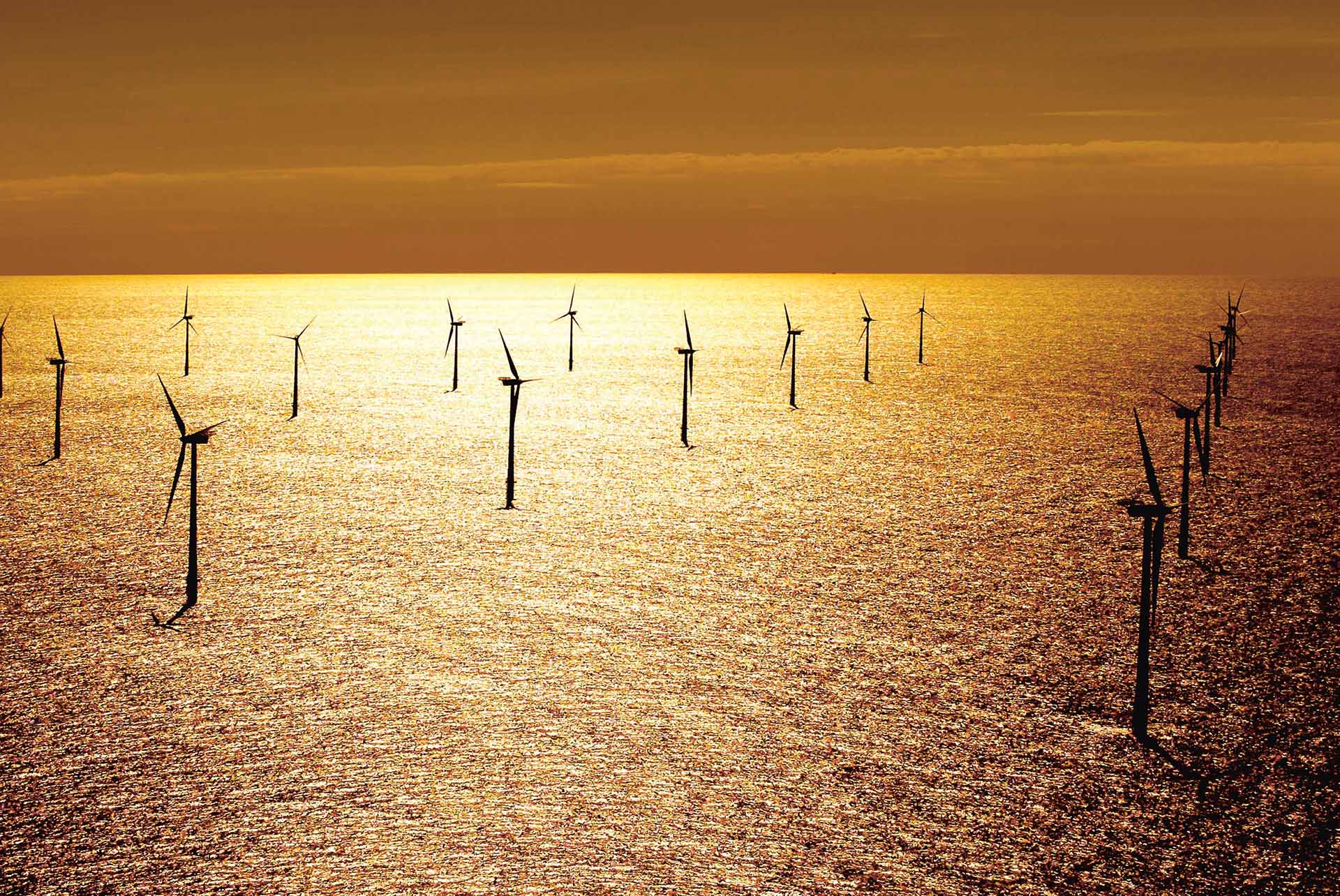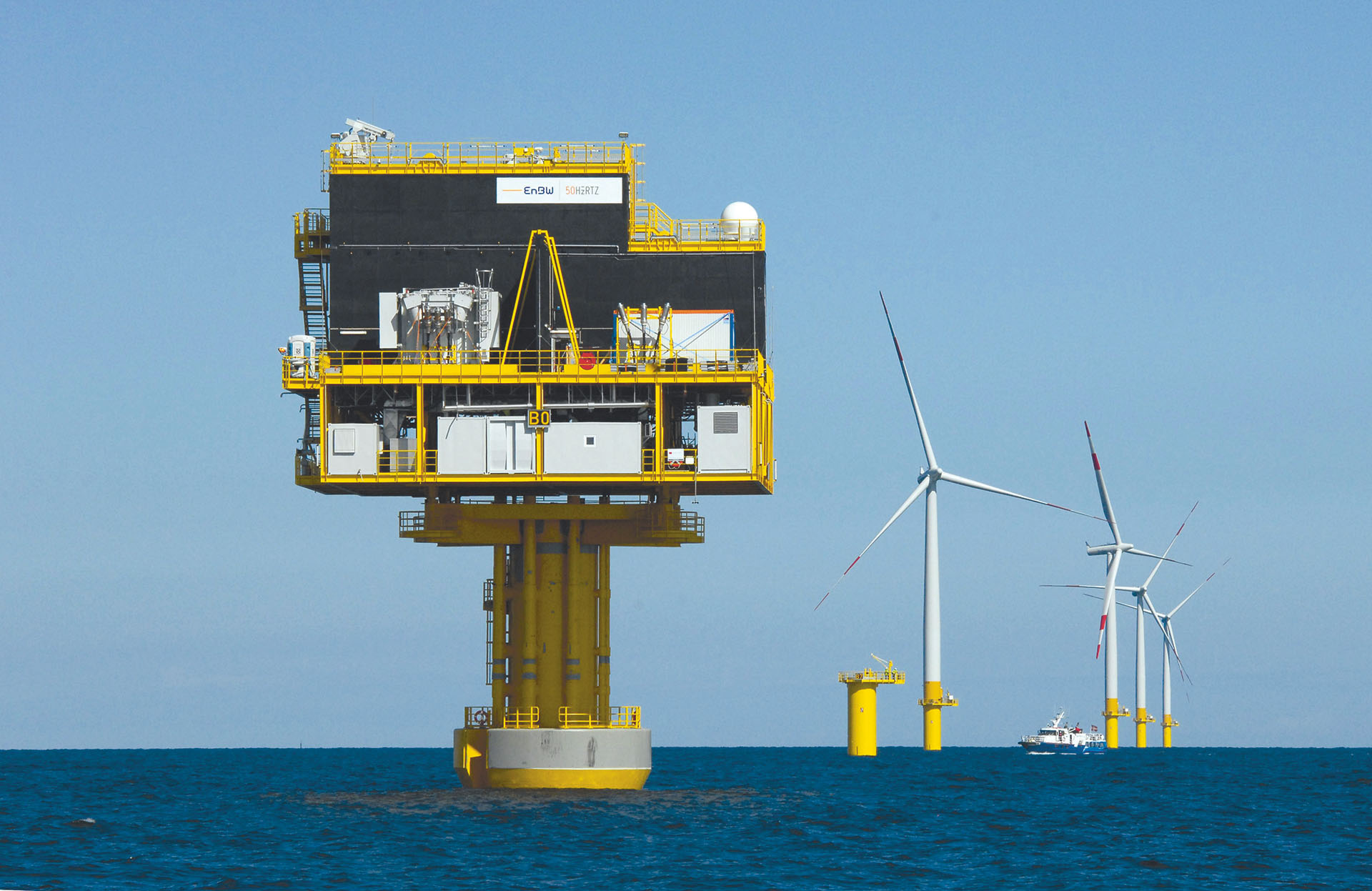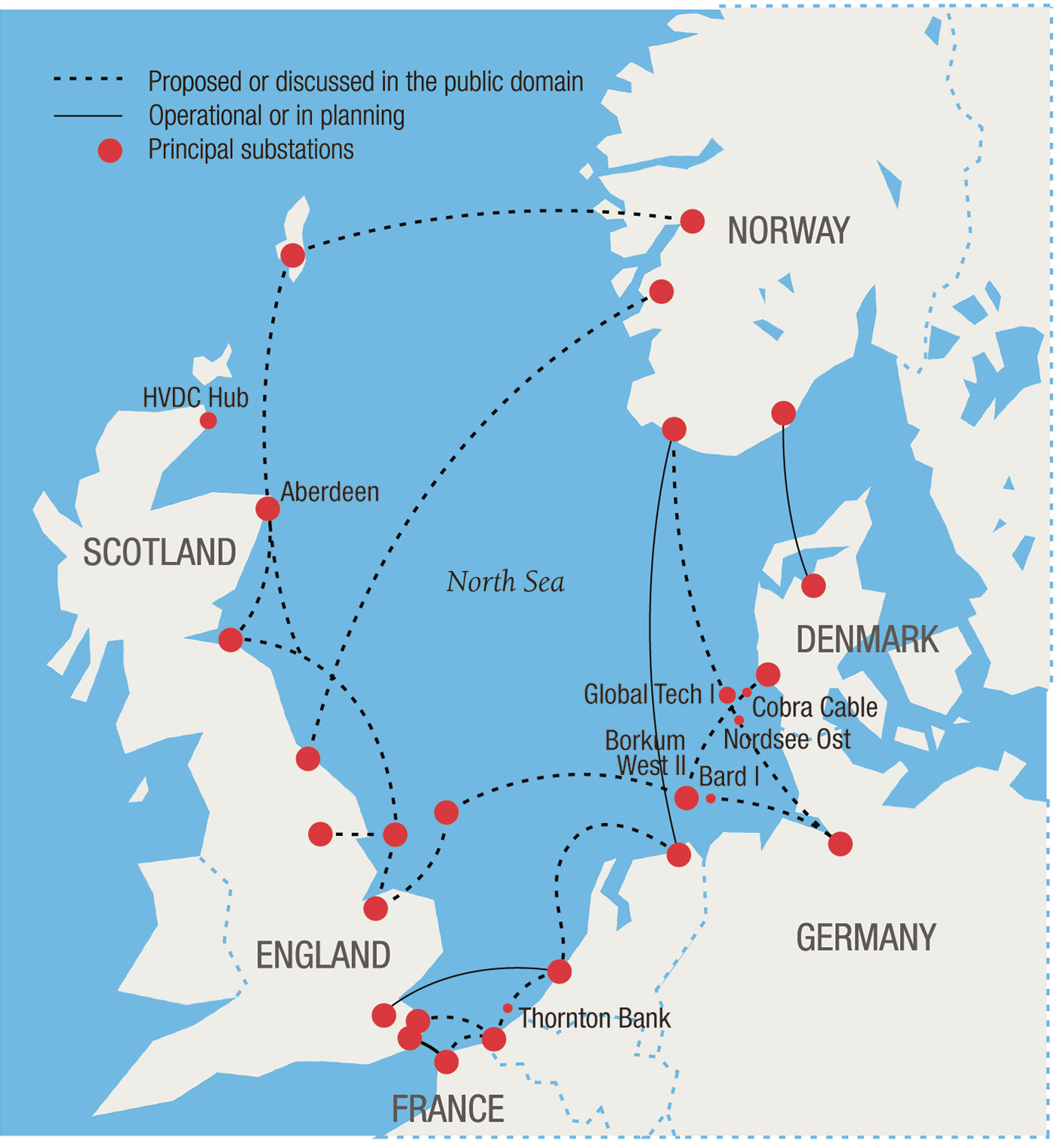Europe’s North Sea Wind Potential
The renewable energy potential from North Sea offshore winds surpasses Europe’s current dependence on Arabian oil. Installing and connecting offshore windfarms with the European onshore grid would turn a major energy supply concern into a pan-European sustainable project. Maria Tvrdonova describes current projections and the challenges ahead.
Decarbonizing Europe’s Energy Sources
Europe faces an energy supply challenge that can be turned into a major continental opportunity. The European Union (EU) has become a global leader in renewable energy technologies, but competition is steep from cheaper Asian products. Maintaining competitiveness, securing energy supplies, and combating climate change by integrating large-scale renewable energy into European grids are the primary objectives that the EU has set for 2020. The EU’s “Roadmap for moving to a competitive low-carbon economy in 2050” goes further and explores routes to decarbonize Europe’s energy future. One of the viable options for cutting carbon emissions forecasts a 75% energy share in gross final energy consumption and up to a 97% share of renewables in electricity consumption by 2050.
Wind energy will play an essential role. Today, wind provides 5.3% of European power but is capable of delivering 12% by 2020 and 50% of the EU’s total electricity consumption by 2050. While onshore wind will remain dominant in the immediate future, in the mid- to long-term planning, offshore wind will play a decisive role in meeting European renewable energy objectives. The potential for offshore development in the seas of Europe’s north-western countries is vast. The European Energy Agency (EEA) estimates that the potential of offshore wind in 2020 could be close to 2,600 terrawatt hours (TWh), which would equate to between 60-70% of Europe’s annual electricity demand projected in 2020.
Compared to onshore wind, offshore farms are more difficult to construct and maintain, resulting in higher capital and operational costs, but they still offer a number of key advantages. Wind at sea is stronger and less variable than on land, resulting in higher production outputs, which brings down the cost per unit installed. Turbines can be larger at sea due to transportation facilitation by ship vessels; larger blades means the wind farms can harness stronger winds and generate more energy.
Offshore wind farms encounter fewer public challenges, less social resistance, than onshore farms do. “Not In My Backyard” (NIMBY) groups pose serious obstacles to deploying any kind of energy infrastructure onshore, which offshore parks are less likely to face, unless it interferes with other maritime interests. Major environmental organizations, such as WWF, Greenpeace and Birdlife support both onshore and offshore wind as the cleanest source of power. In the case of offshore, wind farms protect marine ecosystems and can create synergies by fostering aquaculture for example.
Offshore wind energy can play a key role in decarbonizing Europe’s power sector while sustaining its dominance in wind technologies and innovation, leading to market growth and green job creation along the supply chain. The question now is how to bring electricity produced, in some cases as far as 200 kilometers offshore to the consumer in mainland Europe. Enter: “Supergrid”
Harnessing Offshore Winds
Europe’s interconnected electricity system began in the 1950s. The “grid” includes 24 countries, but resembles more of a patchwork of national grids that were constructed and operated for large nuclear, coal, hydro and gas-fired plants. With the current shifts in the energy paradigm, the outdated and ageing infrastructure is no longer able to serve emerging needs, such as integrating electricity networks into a pan-European “copper-plate” where a customer from Slovakia would be able to purchase electricity produced in Belgium, for instance. And there is nuclear decommissioning after Fukushima as well as the need to integrate larger shares of renewables, notably solar and wind.
Today, wind provides 5.3% of European power but is capable of delivering 12% by 2020 and 50% of the EU’s total electricity consumption by 2050.
The idea of building an interconnected grid that would link the North Sea offshore wind farms with solar in southern Europe, as well as the hydro reserves in Scandinavia and the Alps region, stretching over 5,000km was first introduced by the European Wind Energy Association (EWEA) and Mainstream Renewable Power. Over a dozen analytical studies led by prominent research institutes have assessed the possibilities of harnessing offshore wind and connecting the energy produced to the European electricity system. The projects proposed focus on the offshore wind farms in the North Sea, as well as on the potential of developing interconnectors beyond Europe in North Africa. While the latter is still under debate, the North Seas (North Sea, Baltic Sea, Irish Sea, and the English Channel) offshore Supergrid is in the political pipeline.
In 2010, Energy Ministers from 10 countries (Belgium, the Netherlands, Luxembourg, France, Germany, Ireland, UK, Norway, Sweden, and Denmark) signed a “Memorandum of Understanding” in which they agreed to develop a North Seas offshore grid that would integrate current and future offshore wind farms, known as the North Seas Countries Offshore Grid Initiative. The EU has nurtured the process by encouraging policies and co-funding wind parks and offshore wind technologies, notably through the European Economic Recovery Plan (EERP) as offshore wind and grid markets could create hundreds of thousands of jobs.
Demonstration projects through EERP are complemented by other financial subsidies, such as the EU’s research and innovation framework program. Political will and industrial commitment are significant drivers of the process. In March 2010, numerous key stake-holders including manufacturers, utilities and investors joined forces and established an organization called “Friends of the Supergrid” based in Brussels. The objective is to provide strategic vision and advocacy to the European institutions to promote and create an actual European Supergrid. Despite wind farms being interconnected, as well as political support and industry interest, the Supergrid concept remains theoretical.

The capacity of the European power systems to absorb large amounts of offshore wind is determined by technical and practical constraints as well as by regulatory and economic schemes. Often used as an argument against wind energy, some claim that the variability of wind precludes its large-scale integration due to difficulties of grid operation. This is only partly true. Wind can be an unpredictable and variable source of energy, but the large scale interconnection of wind farms across the North Seas will ensure greater output stability. However, if a large production unit, such as nuclear or coal-fired plant stops operating unexpectedly, the grid balancing becomes much more difficult and costly.
Footing the Bill
Overall costs of building and operating the offshore grid are major issues. Currently, the existing wind farms are linked by lone-standing cables that follow the shortest path to the coast, to limit the rising costs with each additional kilometer of submarine line. The Supergrid however envisages the interconnection of hubs in order to optimize the entire grid. For existing projects, it is very difficult to anticipate the future grid scheme and as a result most projects fall back to lone-standing cable connections, to prevent the risk of stranded costs.
European political commitment is crucial to overcome investment hesitancy in the private sector.
A further expense is the technology used for submarine lines to connect wind farms located more than 50km from the shore, for which high-voltage direct current (HVDC) technology is more suitable than alternating current (AC) cables, traditionally used for onshore transmission, where electricity losses are much higher and major inefficiencies occur over long distances. HVDC technologies are yet to be properly tested in marine conditions and substantial research and development is still needed in HVDC converters, multi-terminal operation solutions, circuit breakers and other technologies currently developed by only a handful of manufacturers. Another cost-determinant is the price of aluminium and copper, which are superconductors used for the cables. The prices are set on fluctuating global markets, creating a very unstable component to the grid’s overall price.
Maintenance costs are also high due to the logistical difficulties in accessing the farms and because only a few companies offer services for offshore sites. During times of economic downturn raising the investments needed for the construction and integration of a wind farm, where the upfront costs can be as much as a billion euros, is not an easy task. The EU and its Member States need to provide assurances to private investors. The research and development funding from the European Commission represents a “quality label” to leverage further investment. This has been done mainly through research framework program funding, EERP, infrastructure funding and, co-managed with the European Investment Bank, loans and equity participation.

Another crucial issue to be resolved is the question of costs and benefits sharing. An offshore grid would potentially benefit all European customers with electricity flowing within the interconnected European electricity grid; resulting in higher security of supply, while contributing to a low-carbon European economy. Apart from investors’ overhead, the costs that are subject to energy regulators’ approval are attributed to tariffs paid by electricity consumers. Should the costs be assumed by all EU consumers, EWEA estimates they will represent 1% of EU consumers’ electricity bills, but as the benefits are uneven and difficult to quantify, the issue of allocation of costs across Member States is a subject for discussion at all energy regulatory conferences all over Europe. Alberto Pototschnig from the Agency for the Cooperation of Energy Regulators (ACER) stated that “when infrastructure provides benefit for two or more jurisdictions there is a problem about how costs are allocated”.
Political (un)certainty
The European Parliament and European Council are debating Commission proposals for financial packages and tools covered under the next budgetary period 2014-2020. Once approved, financial support will come primarily from a new “Infrastructure Package”, which identifies strategic corridors in Europe where energy networks have to be strengthened to ensure secure, competitive and sustainable energy supply. The North Sea area is earmarked as a priority corridor. However, there are strong voices from the Council calling for cuts in the EU budget, including the Infrastructure Package.
If funding is cut radically coupled with the current hardship in the investment markets, Europe could miss its opportunity. What is absolutely crucial in getting over the investment hurdle is European political commitment which would give signals to the industry that the investment flow is secure. A coordinated approach to a European Supergrid would decrease the overall capital costs: “First results showed that planning coordinated, integrated offshore grids allow reducing the amount of unutilized network, with capital costs saving of about 10%.”
Administrative chaos
The long permit process by national authorities is a major obstacle for building offshore infrastructure. Projects have to undergo close scrutiny and are subject to approval from many different bodies, including environmental authorities, maritime spatial planning, regulators, as well as national and regional governments. Permission procedures are one of the most serious threats to creating a common grid in the North Sea. While constructing an energy production unit can take between 3-5 years, the permit procedure and final laying of cables (sub-sea, overhead and underground) may take up to 8 years. An unexpected delay may result in investors withdrawing their funds. The EU is taking steps to resolve this issue with the proposed Infrastructure Package including arrangements to decrease the permit procedures and to set up a one-stop-shop where consent for projects is granted in each country.
Who constructs it?
The EU’s planned 150 gigawatts (GW) installed offshore wind capacity by 2030 and the necessary grid system will require an enormous supply chain as well as a qualified labor force. The onshore bottlenecks need to be solved urgently. There is a lack of adequate harbor infrastructure and the vessels that lay the cables and transport the turbines are fully booked several years in advance. With the right incentives, the high demand for offshore services and products will increase enormously, creating economic growth and thousands of jobs, as is evident in several German harbor cities now.
Projects
Operational and planned grid projects have the potential to serve as the backbone for the European Supergrid because they either increase interconnecting capacity between countries or they are located strategically to optimize future interconnectivity. Of special relevance are projects that bring innovative technical solutions with the potential to be replicated, thus shortening the time for the interconnected North Sea offshore grid to become linked with the onshore grid.

The planned East-West Interconnector between Ireland and Wales will add 500 MW of interconnection between the two countries.
Completed in 2011, BritNed connects the UK and the Netherlands with an interconnector with a continuous electric capacity of 1,000 MW.
Scheduled to be operational by 2016, the Cobra Cable is a 700 MW HVDC interconnector between the Netherlands and Denmark.
The strategic partners NorGer and NordLink aim to interconnect Norway with Continental Europe, allowing the Norwegian hydro plants to serve as batteries for Europe at times when there is less sun and wind. Norway would benefit from European electricity capacities during periods with less rainfall.
NorthConnect plans to build a merchant line between Scotland and Norway.
Contrary to the traditional way of connecting offshore wind power plants by using lone-standing lines, Kriegers Flak project is developing an innovative, cross-border solution based on the dual-purpose to increase capacity between countries, allowing for better energy trading.
The practical challenges associated with developing the Supergrid are not insurmountable.
In January 2010, a licence was granted for a wind farm in the Dogger Bank area. Apart from using its 9 GW capacity, this project can become a hub interconnecting surrounding countries due to its central location in the North Sea. Construction is planned to start in 2014.
Germany has been rapidly moving its energy production to offshore sites. Several German wind farm projects, Bard I, Global Tech I, Nordsee Ost, Borkum West II, are co-funded by the EERP, based on their innovative turbines and offshore structures. Similarly, the Thornton Bank in the Belgian North Sea is being supported on the basis of its innovativeness and replication potential.
An offshore hub on the planned HVDC link between the Shetland Islands and Scotland is another prioritised project with a multi-terminal platform for the connection of windfarms and marine energy generation.
Looking to 2050
No Supergrid Master Plan currently exists. If a bottom-up approach is embarked upon rather than top-down policy implementation, then interconnecting the wind farms and other sources of renewable energy would be driven largely by economic forces. The system would resemble independently-managed, although interconnected grids, operating at different voltage levels, depending on the technology available when they are built.
One can argue against overregulation and for market development, but in the case of a pan-European project of such significance, a top-down process may be best. This role should be taken by the European Commission which needs to react on several fronts in order to create a level-playing field by harmonizing regulatory frameworks, subsidize technological development, and ensure the leverage effect for private industry to participate as well.
The proposed visions of a European Supergrid draw on Europe’s indigenous renewable energy potential located far from the demand of urban areas. It is commonly perceived that the Supergrid would bring many advantages to the entire European electricity system, on the level of sustainability, supply security, system reliability, market liquidity, industry and related technology development. The practical challenges associated with developing the Supergrid are not insurmountable.
Clear signals are needed for investors to generate solutions. The source is a unified political commitment by the EU and its Member States to encourage private sector investments, decrease costs, and allow for positive network externalities by increasing the number of (direct or indirect) Supergrid beneficiaries.
The EU has several instruments available to guide the development of the offshore grid. Synergies between these instruments are needed to achieve the most efficient results of linking technology research and development to the EU’s infrastructure priorities established in the proposed Energy Infrastructure Regulation.
A European Supergrid is a long-term project: the economic rentability is some four decades away. Energy demands and energy security makes the Supergrid the most ambitious energy endeavor of the 21st century for Europe. As described by Eddie O’Connor, CEO of Mainstream Renewable Power: “The Supergrid concept has been called ‘visionary and revolutionary’. To us, it’s just common sense.”